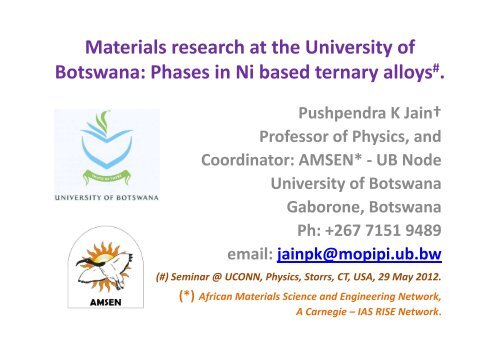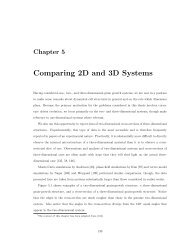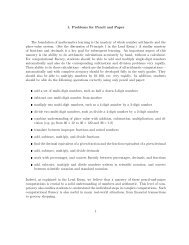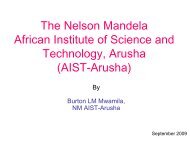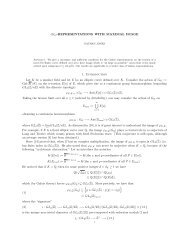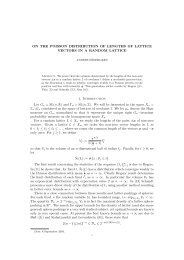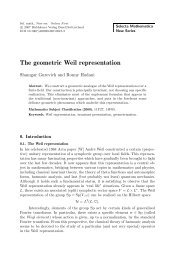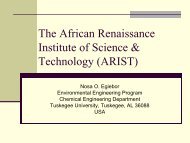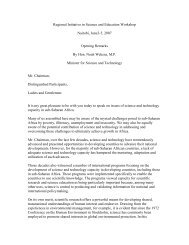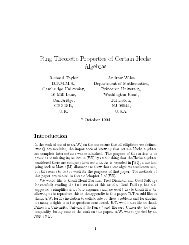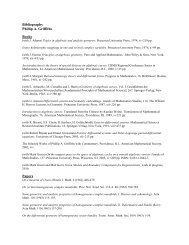Phases in Ni based ternary alloys - Science Initiative Group
Phases in Ni based ternary alloys - Science Initiative Group
Phases in Ni based ternary alloys - Science Initiative Group
You also want an ePaper? Increase the reach of your titles
YUMPU automatically turns print PDFs into web optimized ePapers that Google loves.
Materials research at the University of<br />
Botswana: <strong>Phases</strong> <strong>in</strong> <strong>Ni</strong> <strong>based</strong> <strong>ternary</strong> <strong>alloys</strong> # .<br />
Pushpendra K Ja<strong>in</strong>†<br />
Professor of Physics, and<br />
Coord<strong>in</strong>ator: AMSEN* - UB Node<br />
University of Botswana<br />
Gaborone, Botswana<br />
Ph: +267 7151 9489<br />
email: ja<strong>in</strong>pk@mopipi.ub.bw<br />
(#) Sem<strong>in</strong>ar @ UCONN, Physics, Storrs, CT, USA, 29 May 2012.<br />
(*) African Materials <strong>Science</strong> and Eng<strong>in</strong>eer<strong>in</strong>g Network,<br />
A Carnegie – IAS RISE Network.
(†) UCONN Alumni<br />
Class of 1975: PhD Physics<br />
1. Introduction: Botswana<br />
2. University of Botswana<br />
3. FoS Shared Research<br />
Facilities<br />
4. Materials Research<br />
Fund<strong>in</strong>g: AMSEN<br />
5. <strong>Phases</strong> <strong>in</strong> <strong>Ni</strong> - super <strong>alloys</strong>.<br />
6. The <strong>Ni</strong> – Ru – Zr system<br />
7. Sample preparation<br />
8. SEM, EDX and XRD analysis<br />
9. Solidus & Liquidus<br />
projections.
Republic of Botswana<br />
Location: 17 o – 27 o S<br />
20 o – 30 o E<br />
Area: 224 607 Sq mi<br />
(581 730 Sq km)<br />
(~ Size of France)<br />
Population: 2 Million<br />
GNP: ~ 8 Billion US$<br />
(Upper Middle Income)<br />
Economy: Diamonds<br />
Beef products<br />
Cattle: 3-4 Million
Capital city: Gaborone
University of Botswana (UB)
1964: UBBS<br />
1966: UBLS<br />
1975: UBS<br />
1982: UB Established.<br />
•2 Schools + 7 Faculties<br />
Faculty of <strong>Science</strong>:<br />
7 Departments<br />
1. Biology 2. Chemistry<br />
2011-2012: Present status 3. Computer <strong>Science</strong><br />
•Staff: 2,679<br />
4. Environmental <strong>Science</strong><br />
Academic: 823<br />
•Students: 15,731<br />
Full time: 12,626<br />
Graduate: 1,391<br />
(PGDiploma, MA, MPhil, PhD)<br />
5. Geology 6. Mathematics<br />
7. PHYSICS<br />
Research Facilities:<br />
Faculty Shared<br />
Department <strong>based</strong>.
Faculty of <strong>Science</strong> Shared Facilities<br />
7 Research and support Units: Each unit<br />
Managed by a Department.<br />
Headed by a Research Scientist<br />
Assisted by Technical staff.<br />
Electron Microscope Unit<br />
X-ray Diffraction Unit<br />
(Geology)<br />
Inductively Coupled MSU<br />
(Geology)<br />
Mass Spectroscopic Unit<br />
(Chemistry)<br />
NMR Unit<br />
(Chemistry)<br />
Glass blow<strong>in</strong>g (support) unit (Chemistry)<br />
Liquid nitrogen plant (support) (Physics)<br />
(Physics)
Electron Microscope Unit (EMU)<br />
•XL 30 ESEM with EDX<br />
•Technai 12 TEM<br />
•Accessories and Ancillaries for<br />
SEM and TEM.<br />
•Light Microscopes (LM):<br />
•Zeiss Axioskp Transmitted LM<br />
•<strong>Ni</strong>kon SMZ 100 Stereo LM<br />
•Axiovert 200 Mat Inverted LM
X-ray Diffraction Unit (XRDU)<br />
•Philips PW 3710 mpd<br />
controlled XRD with PW 1752<br />
graphite monochromator.<br />
o PW 1830 Generator<br />
o PW 3020 vertical goniometer<br />
o PW 3011 Xe detector<br />
o PW 1386/55 auto divergence slit<br />
o X’PERT 2000 data collection and<br />
analysis software<br />
o V30 water chiller, and<br />
o V40 compressor
Inductively Coupled Mass Spectrometer Unit<br />
(ICPMSU)<br />
•F<strong>in</strong>nigan MAT Element 2<br />
High Resolution ICPMS<br />
o<br />
o<br />
CETAC LSX-200 Plus<br />
Laser Ablation (LA)<br />
Varian Pro-Star High<br />
Performance Liquid<br />
Chromatograph (HPCL)
Mass Spectroscopy Unit (MSU)<br />
•F<strong>in</strong>nigan Mat SSQ 7000 MS<br />
s<strong>in</strong>gle quadrupole with GC-MS,<br />
EI, CI, APCI, and ESI facilities.<br />
•LCQ DECA Ion Trap MS<br />
(with a dedicated<br />
chromatographic system, an auto<br />
sampler, and a diode array<br />
detector.)<br />
Can be coupled to a micro-high<br />
performance anion exchange<br />
chromatographic (HPAEC)<br />
system or a Capillary<br />
electrophoresis (CE) system.<br />
•Over 240 000 Spectra library.
Nuclear Magnetic Resonance Unit (NMRU)<br />
•Bruker DMX Avance 300<br />
NMR Unit with QNP and BBI<br />
probes (2) and a 60 sample<br />
changer carousel.<br />
•Bruker DRX Avance 600<br />
NMR Unit with Selective<br />
Inverse, Dual and Broad<br />
Band probes (3)
Departmental Research Labs.<br />
PHYSICS:<br />
•Th<strong>in</strong> films deposition<br />
and characterization lab.<br />
o Edwards Auto 500 RF<br />
Magnetron sputter<strong>in</strong>g unit.<br />
o KLA-Tencor P15 Surface<br />
Profiler (Accuracy: ±15 Å).<br />
o Varian CAREY 500 UV -<br />
Visible – NIR Spectrometer<br />
for solid and th<strong>in</strong> film<br />
samples.<br />
MECHANICAL ENGG:<br />
•Materials test<strong>in</strong>g Lab.<br />
PHYSICS - Other Research:<br />
•Geophysics Research Lab.<br />
•Atmospheric Pollution<br />
Studies Lab.<br />
•Radiation Physics Lab.<br />
•Solar Radiation<br />
Measurement Lab.
Materials Research Fund<strong>in</strong>g:<br />
The AMSEN Project<br />
AMSEN: The African Materials <strong>Science</strong> and<br />
Eng<strong>in</strong>eer<strong>in</strong>g Network:<br />
A Carnegie – IAS – RISE Network of 5 African Universities:<br />
•University of Botswana<br />
• U. Namibia<br />
•Wits University, South Africa<br />
• U. Nairobi (Kenya)<br />
•Federal University of Technology, Akure, <strong>Ni</strong>geria<br />
•Funded by Carnegie Corporation through the<br />
Regional <strong>Initiative</strong> <strong>in</strong> <strong>Science</strong> and Education (RISE) at the<br />
Institute of Advanced Study (IAS) Pr<strong>in</strong>ceton, USA.<br />
Phase1: 2008 – 2011 (Completed)<br />
Phase 2: 2011 – 2013 – On go<strong>in</strong>g.<br />
Beyond 2013: Negotiations with World Bank: (To scale up x4).
Objectives of AMSEN<br />
• Capacity build<strong>in</strong>g <strong>in</strong> Materials Research through<br />
Manpower Tra<strong>in</strong><strong>in</strong>g.<br />
Tra<strong>in</strong><strong>in</strong>g of new staff at MPhil/ PhD level.<br />
Build<strong>in</strong>g supervisory capacity thru co-supervision.<br />
Creation of research facilities and <strong>in</strong>frastructure.<br />
New equipment/ repair/ ma<strong>in</strong>tenance/ shar<strong>in</strong>g.<br />
•AMSEN fund<strong>in</strong>g used for:<br />
<br />
<br />
<br />
<br />
<br />
Full students’ bursaries – Tuition/ Medical/ Personal.<br />
Research cost – materials and publications cost.<br />
Equipment – repair, ma<strong>in</strong>tenance, new equipment.<br />
Tra<strong>in</strong><strong>in</strong>g - workshops and short courses.<br />
Travel - conferences, workshops and research visits.
AMSEN at UB:<br />
UB Node of AMSEN Coord<strong>in</strong>ated by Pushpendra Ja<strong>in</strong><br />
• 2 PhD + 2 MPhil students at UB work<strong>in</strong>g on:<br />
<br />
<br />
<br />
Composite systems us<strong>in</strong>g organic fibers.<br />
Si – In – Bi Th<strong>in</strong> films: Phase change materials for<br />
data storage.<br />
<strong>Ni</strong> <strong>based</strong> <strong>ternary</strong> <strong>alloys</strong> – Supervised by myself (PKJ):<br />
<strong>Ni</strong> – Ru – V system (Part-time PhD student I Physics)<br />
<strong>Ni</strong> – Ru – Zr system (MPhil student <strong>in</strong> Mech Engg.)<br />
•Co-supervision (PKJ) of a PhD student at Wits and a<br />
MSc student at Nairobi (Completed – December 2011).<br />
•Have organized 5 short tra<strong>in</strong><strong>in</strong>g courses/ workshops to date for<br />
staff and students from all AMSEN nodes.<br />
•Staff and students have attended Conferences/ workshop.
UB – AMSEN Family: An Introduction<br />
Batane, Chipise, Rabalone, Ja<strong>in</strong>, Coetzee, Sathiaraj, Muiva<br />
CORNISH MODISI MOKALOBA FLORANCE<br />
March 2012<br />
17
<strong>Phases</strong> <strong>in</strong> Ternary Alloys: Work at UB<br />
• <strong>Ni</strong> <strong>based</strong> Ternary <strong>alloys</strong> (Super <strong>alloys</strong>):<br />
<strong>Ni</strong>-Ru-Y system: MPhil – Stephen (Completed)<br />
<strong>Ni</strong>-Ru-Zr system: MPhil – Liberty (Ongo<strong>in</strong>g)<br />
<strong>Ni</strong>-Ru-V system: PhD – Stephan (Ongo<strong>in</strong>g)<br />
(Potential application: Jet eng<strong>in</strong>e and Power turb<strong>in</strong>es).<br />
• <strong>Ni</strong>-V-C be<strong>in</strong>g <strong>in</strong>vestigated by Apata (PhD) at Wits<br />
University (Co-supervised by PKJ):<br />
(Potential application <strong>in</strong> high corrosion petrochemical and<br />
related <strong>in</strong>dustries.)<br />
•Our focus today is on <strong>Ni</strong>-<strong>based</strong> super <strong>alloys</strong>.
<strong>Ni</strong> <strong>based</strong> supper <strong>alloys</strong><br />
Super <strong>alloys</strong>:<br />
oHigh Temperature application: ~0.8 x melt<strong>in</strong>g temp.<br />
oHigh creep and oxidation resistance at high temp.<br />
oHigh corrosion resistance at high temp.<br />
oCommon super <strong>alloys</strong>: Iron, Cobalt, <strong>Ni</strong>ckel <strong>based</strong>.<br />
•<strong>Ni</strong> (melt<strong>in</strong>g temp: 1455 o C) super <strong>alloys</strong> suited for<br />
jet eng<strong>in</strong>es and turb<strong>in</strong>es applications.<br />
oTo <strong>in</strong>crease their temperature of operation (say<br />
~1300 o C) to achieve:<br />
Improved efficiency,<br />
Reduced fuel consumption,<br />
Reduced environmental pollution.
Alloy<strong>in</strong>g Additives: Why and Which?<br />
•Alloy<strong>in</strong>g additives <strong>in</strong> steels are used to:<br />
Solid solution strengthen<strong>in</strong>g.<br />
Improve corrosion resistance.<br />
Improve hardenability.<br />
Phase stability.<br />
Reduce rate of temper<strong>in</strong>g…..<br />
•Physical Parameters to Consider:<br />
•Atomic size factor: For <strong>Ni</strong> <strong>alloys</strong>: V, Cr, Fe. Mn. etc.<br />
•Solubility factor: For <strong>Ni</strong> <strong>alloys</strong>: Ru, V, Cr, Ti, Al, Au, Cu, W.<br />
•Diffusivity: W, Mo, Cr, V, Fe, Co, Au, Cu.<br />
•Crystal structure: <strong>Ni</strong> 3 X compounds with FCC structure<br />
where X → Al, Ti, V, Mn, Fe, Mo, Co etc.
Ru:<br />
Choice of <strong>Ni</strong> <strong>based</strong> Ternaries!<br />
• Increases corrosion resistance of sta<strong>in</strong>less<br />
steels and Ti <strong>alloys</strong>.<br />
• Extensive solubility of <strong>Ni</strong> and Ru<br />
→ Our focus is on <strong>Ni</strong>-Ru b<strong>in</strong>ary for <strong>Ni</strong> super <strong>alloys</strong>.<br />
Y: Surface stabilizer by form<strong>in</strong>g oxides.<br />
V: Atomic size factor and diffusivity.<br />
Zr: Alleviates embrittlement of <strong>in</strong>ternal surfaces like<br />
gra<strong>in</strong> boundaries.<br />
→ We Considered 3 <strong>Ni</strong> <strong>based</strong> ternaries not<br />
found <strong>in</strong> literature:<br />
<strong>Ni</strong>-Ru-Y; <strong>Ni</strong>-Ru-V; and <strong>Ni</strong>-Ru-Zr
B<strong>in</strong>ary systems<br />
• Are essential to <strong>in</strong>terpret<br />
the analysis of ternaries.<br />
•A b<strong>in</strong>ary phase diagram<br />
(@ constant pressure) has<br />
at% (wt%) composition<br />
along the horizontal and<br />
temperature along the<br />
vertical.<br />
•Liqidus and solidus<br />
curves separate all liquid<br />
and all solid phases from<br />
the mixed phase regions,<br />
for example: →<br />
B<strong>in</strong>ary PD of completely<br />
miscible liquids and<br />
completely immiscible solids<br />
(with eutectic reaction):
B<strong>in</strong>aries associated with a <strong>ternary</strong><br />
•3 B<strong>in</strong>aries are associated with a <strong>ternary</strong> system.<br />
•From the b<strong>in</strong>ary PDs solidification reaction and<br />
the b<strong>in</strong>ary phases at different compositions are<br />
deduced as a function of temperature.<br />
•All known b<strong>in</strong>ary systems are all well<br />
understood and extensively studied.<br />
•These PDs could be quite complex .<br />
•For example, b<strong>in</strong>aries associated with the<br />
<strong>Ni</strong> – Ru - Zr <strong>ternary</strong> are <strong>Ni</strong> - Ru, <strong>Ni</strong> - Zr, Ru - Zr as<br />
shown <strong>in</strong> the follow<strong>in</strong>g slides:
<strong>Ni</strong> – Ru b<strong>in</strong>ary (Massalki 2007)<br />
(Simple peritectic system)
<strong>Ni</strong> – Zr b<strong>in</strong>ary (Okamoto 1993)<br />
(Complex system with Eight <strong>in</strong>termetallic phases)
Ru – Zr b<strong>in</strong>ary (Okamoto 2007)<br />
(Two <strong>in</strong>termetallic phases)
Ternary Phase Diagram<br />
•Are plotted <strong>in</strong> 3D.<br />
•3 axis along an equilateral<br />
∆ <strong>in</strong> the horizontal plane<br />
give <strong>ternary</strong> composition.<br />
•Temperature is along the<br />
vertical axis.<br />
•Vertical planes through<br />
the sides of the ∆<br />
correspond to the b<strong>in</strong>ary<br />
PDs.<br />
•Liquidus and solidus<br />
curves <strong>in</strong> b<strong>in</strong>ary PDs<br />
become the surfaces.
Isothermal section of the <strong>ternary</strong> PD<br />
•An isothermal section of a<br />
<strong>ternary</strong> PD is an equilateral<br />
triangular composition grid.<br />
•(X-) along the three axis gives<br />
the at% (wt%) composition of<br />
each constituent A, B and C of<br />
the <strong>ternary</strong>.<br />
•We use such composition grids<br />
to analyze phase composition<br />
data, to display the phases and<br />
extent of phases, and liquidus<br />
and solidus projection of our<br />
<strong>ternary</strong> systems.
Materials and sample preparation<br />
•99.9% pure elements are used for the alloy samples.<br />
(Adds to the high cost of consumables).<br />
•Large % of Impurities if present results <strong>in</strong> an alloy of<br />
higher order than <strong>ternary</strong>.<br />
•Samples are made <strong>in</strong> batches of 6, limited by the furnace<br />
design.<br />
•First batch of samples is chosen to be equally spaced on<br />
the <strong>ternary</strong> composition grid.<br />
•Constituent elements for a 2g sample are weighed,<br />
mixed thoroughly, and compacted <strong>in</strong> to a pallet.<br />
•Compacted pallets are melted <strong>in</strong> an arc furnace with<br />
water cooled copper hearth <strong>in</strong> an argon atmosphere to<br />
prepare “2 g alloy buttons”.
First<br />
batch of<br />
six alloy<br />
samples
At% composition of the first batch of<br />
six samples of <strong>Ni</strong>-Ru-Zr alloy.<br />
Sample <strong>Ni</strong> at% Ru at% Zr at%<br />
1 20 40 40<br />
2 20 60 20<br />
3 20 20 60<br />
4 40 20 40<br />
5 60 20 20<br />
6 40 40 20
Representative mass calculation for a 2g<br />
<strong>Ni</strong> 20 : Ru 40 :Zr 40 alloy sample..<br />
Sample Element<br />
Atomic<br />
Mass At %<br />
Mass (g)<br />
<strong>in</strong><br />
sample<br />
Mass (g)<br />
<strong>in</strong> 2g<br />
sample<br />
<strong>Ni</strong> 58.6934 20.00% 11.73868 0.2648<br />
Ru 101.0700 40.00% 40.42800 0.9120<br />
1<br />
Zr 91.2240 40.00% 36.48960 0.8231<br />
SUM 250.9874 100.00% 88.65628 2
Arc melt<strong>in</strong>g of alloy samples<br />
•6 compacted pallets and a “Tioxygen<br />
getter “are placed <strong>in</strong>side<br />
the furnace with a dome and a<br />
view<strong>in</strong>g w<strong>in</strong>dow.<br />
• Dome is evacuated, flushed with<br />
“Pure argon”; process repeated 3<br />
times, and then filled with argon.<br />
•Ti is melted first to absorb traces<br />
of O 2 by oxidation of Ti.<br />
•Next the pallets are melted to cast<br />
the alloy buttons.<br />
•Each button is turned and melted<br />
aga<strong>in</strong>; process repeated 3 times for<br />
thorough mix<strong>in</strong>g.
Metallographic preparation of as cast samples<br />
•Alloy buttons are sectioned <strong>in</strong> two halves;<br />
one half preserved for heat treatment studies later;<br />
and<br />
Second half is prepared for as-cast sample analysis.<br />
•The second half is mounted <strong>in</strong> cold epoxy res<strong>in</strong>; ground<br />
on successive grade (#25 0→ #2400) emery papers to<br />
remove cutt<strong>in</strong>g-scratches; polished to 1µm f<strong>in</strong>ish with<br />
diamond paste.<br />
•Polished samples given a th<strong>in</strong> carbon coat<strong>in</strong>g to prepare<br />
them for SEM analysis.<br />
•BSE imag<strong>in</strong>g and EDX analysis are used as the SEM<br />
analytical tools to deduce solidification reactions and<br />
determ<strong>in</strong>e phases compositions.
Samples analysis: Solidification reactions<br />
•<strong>Phases</strong> dist<strong>in</strong>guished from contrast <strong>in</strong> Back scatter electron<br />
(BSE)-SEM image, (larger atomic number → brighter image).<br />
•Orientation, and cor<strong>in</strong>g also effects contrast.<br />
•Solidification reactions are <strong>in</strong>ferred from shapes of the<br />
phases, e.g..<br />
Oxides, if any, are the first to form and do not participate<br />
solidification reactions, may act as nucleation sites.<br />
Dendrites/ needles are the first to solidify.<br />
Liquid then solidifies outwards from the dendrites.<br />
Irregular (chewed-up) edges of the solid phase po<strong>in</strong>t to<br />
peritectic reaction .<br />
Eutectic is the last to solidify as a mix of dark and light regions<br />
from simultaneous growth of two or more phases. (zebra like<br />
appearance).
BSE – SEM images of some<br />
solidification processes
BSE Image of and <strong>Phases</strong> <strong>in</strong> as cast<br />
<strong>Ni</strong> 19 :Ru 20 :Zr 61
Solidification reactions <strong>in</strong> as cast<br />
<strong>Ni</strong> 19 :Ru 20 :Zr 61<br />
L → Light<br />
L + Light → Medium dark,<br />
locally.<br />
L + Medium dark →<br />
Medium, locally<br />
L + Light → Medium<br />
L → ~ZrRu<br />
(L + ~ZrRu → τ 2 locally)<br />
L + τ 2 → ~Zr 2 <strong>Ni</strong>, locally)<br />
L + ~ZrRu → ~Zr 2 <strong>Ni</strong>.
Sample analysis: Phase compositions<br />
•Composition of different contrast regions (phases) is<br />
determ<strong>in</strong>ed from EDX analysis.<br />
•F<strong>in</strong>al composition is the mean of at least five analyses of the<br />
same contrast region.<br />
•A region must be at least 3µm across for accurate analysis.<br />
•Smaller regions are effected by the neighbor<strong>in</strong>g regions<br />
result<strong>in</strong>g <strong>in</strong> large uncerta<strong>in</strong>ty.<br />
•Composition of all the phases are plotted on the <strong>ternary</strong><br />
composition grid.<br />
•The overall composition must fall with<strong>in</strong> the area enclosed<br />
by the tie l<strong>in</strong>es of the identified phases.<br />
•<strong>Phases</strong> are tentative identified by compar<strong>in</strong>g the po<strong>in</strong>ts on<br />
the plot to the nearest b<strong>in</strong>ary phases.
EDX analysis of as cast<br />
<strong>Ni</strong> 19 :Ru 20 :Zr 61<br />
Phase Description<br />
Composition at.%<br />
<strong>Ni</strong> Ru Zr<br />
Overall 18.8±0.2 19.9 ±0.3 61.3± 0.1<br />
Light (dendrites) 12.9±0.4 38.8±0.7 48.3±0.3<br />
Inner-dendritic (ID) 13.6±1.0 38.1±0.9 48.4±0.2<br />
Medium 24.6±0.5 10.0±0.5 65.4±0.6<br />
Medium dark 20.7±0.5 6.1±0.4 73.2±0.2<br />
Dark 13.3±0.1 4.0±0.4 83.0±0.2
EDX plot of as cast <strong>Ni</strong> 19 :Ru 20 :Zr 61<br />
on Ternary Composition Grid
Sample analysis: Phase identification<br />
•<strong>Phases</strong> are confirmed and identified from the XRD<br />
analysis of the samples and by match<strong>in</strong>g peaks from the<br />
data base.<br />
•As known b<strong>in</strong>ary phases of our <strong>ternary</strong> system are all<br />
known, the unidentified peaks <strong>in</strong> the XRD spectra po<strong>in</strong>t to<br />
new <strong>ternary</strong> phases. In the system.<br />
•Position of the unidentified phases on the <strong>ternary</strong> plot<br />
support the presence of <strong>ternary</strong> phases <strong>in</strong> the system as<br />
such po<strong>in</strong>ts are far from the known b<strong>in</strong>ary phases.<br />
•Next we go back to solidification reaction, and express<br />
them <strong>in</strong> terms of the phases identified.
XRD spectra of as cast<br />
<strong>Ni</strong> 19 :Ru 20 :Zr 61<br />
Counts<br />
<strong>Ni</strong>RuZr4<br />
1000<br />
Ru Zr; Zr2 <strong>Ni</strong><br />
500<br />
Zr2 <strong>Ni</strong><br />
Ru Zr<br />
Zr2 <strong>Ni</strong><br />
0<br />
30 40 50 60 70 80<br />
Position [°2Theta] (Copper (Cu))
More samples analysis<br />
•This is the complete storey of analysis of one sample.<br />
•Likewise all the six samples <strong>in</strong> the batch are analyzed, and<br />
plotted together on the <strong>ternary</strong> composition grid.<br />
•Next a second batch of six samples is cast with<br />
compositions selected to fill the gaps on the composition<br />
grid; samples analyzed, and plotted on the same grid with<br />
the first batch.<br />
•F<strong>in</strong>ally third batch of six samples is cast to fill the<br />
rema<strong>in</strong><strong>in</strong>g gaps or to <strong>in</strong>vestigate certa<strong>in</strong> region of the grid <strong>in</strong><br />
details; samples analyzed.<br />
•In the end we have 18 samples plotted on the grid.<br />
•This is generally sufficient data to be able plot solidus<br />
surface and liquidus projection of the <strong>ternary</strong> system.
18 samples plot of the <strong>Ni</strong>-Ru-Zr<br />
<strong>ternary</strong> alloy
Solidus projection surface of the <strong>Ni</strong>-Ru-Zr<br />
<strong>ternary</strong> alloy
Liquidus projection surface of the<br />
<strong>Ni</strong>-Ru-Zr <strong>ternary</strong> alloy
Conclusion and further work<br />
•<strong>Phases</strong> <strong>in</strong> as cast <strong>Ni</strong>-Ru-Zr alloy are identified,<br />
•Four new <strong>ternary</strong> phases were found.<br />
τ 1 with composition ~Zr 24 Ru 31 <strong>Ni</strong> 45<br />
τ 2 with composition ~Zr 79 Ru 3 <strong>Ni</strong> 18<br />
τ 3 with composition ~Zr 34 Ru 4 <strong>Ni</strong> 62 , and<br />
τ 4 with composition ~Zr 47 Ru 22 <strong>Ni</strong> 31<br />
To study at least one sample of composition <strong>Ni</strong> 27 :Ru 63 :Zr 10<br />
at.%, to verify the direction of the liquidus surface<br />
To anneal as-cast samples for isothermal section.<br />
To determ<strong>in</strong>e the crystal structures of the <strong>ternary</strong> phases.
“Millennium Etched <strong>in</strong> a Rock: A Geological Calendar”<br />
First Prize: Micrograph Competition – MSSA2005,<br />
44th Annual Conference of the MSSA, December 2005,<br />
and<br />
Image of Dist<strong>in</strong>ction Award: <strong>Ni</strong>kon’s Small World 2009
Ja<strong>in</strong> family: December 2011


